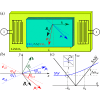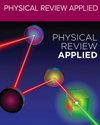具有非共线层磁化的铁磁双层中与自旋波耦合的表面声波的非互易性
IF 4.4
2区 物理与天体物理
Q2 PHYSICS, APPLIED
引用次数: 0
摘要
利用声表面波与在磁性异质结构中传播的自旋波(SW)之间的磁弹性相互作用,可以实现声表面波在微波频段的非互易传播。最近的研究表明,在由合成反铁磁体--具有反铁磁性 Ruderman-Kittel-Kasuya-Yosida 层间耦合的铁磁(FM)双层结构--放置在压电声波导顶部的异质结构中,可以实现反传播杂化 SAW/SW 的最终隔离。在这项工作中,我们详细研究了一个基于调频双电层的更实用、技术上更简单的系统,其中各层仅通过偶极-偶极相互作用耦合,并且调频层的磁化不共线。研究表明,各层中具有非共线易轴的微弱面内各向异性是实现混合声表面波/声表面波强非对等传播的唯一基本因素。我们提出了实现高效声表面波隔离器所需的层磁化相对方向和波传播方向的要求,并演示了声表面波传输特性的示例,证明亚毫米长的调频双层膜可以实现超过 50 dB 的隔离度,而插入损耗仅比纯声表面波器件高出几个分贝。除了相对简单的制造工艺外,所提出的磁弹性异质结构对各向异性轴和/或偏置场方向的偏差表现出合理的鲁棒性--这对器件的大规模生产具有重要的好处。本文章由计算机程序翻译,如有差异,请以英文原文为准。

Nonreciprocity of surface acoustic waves coupled to spin waves in a ferromagnetic bilayer with noncollinear layer magnetizations
Nonreciprocity of propagation of surface acoustic waves (SAWs) in the microwave frequency band can be achieved using the magnetoelastic interaction of SAWs with spin waves (SWs) propagating in magnetic heterostructures. Recent works have shown that the ultimate isolation of a counterpropagating hybridized SAW/SW is achieved in heterostructures consisting of a synthetic antiferromagnet—a ferromagnetic (FM) bilayer with antiferromagnetic Ruderman-Kittel-Kasuya-Yosida interlayer coupling—placed on top of a piezoelectric acoustic waveguide. In this work, we study in detail a more practical and technologically simpler system based on an FM bilayer, where layers are coupled by only dipole-dipole interaction, and having noncollinear magnetizations of the FM layers. A weak in-plane anisotropy with noncollinear easy axes in the layers is shown to be the only essential factor for the realization of strongly nonreciprocal propagation of a hybridized SAW/SW. We formulate requirements for the relative orientation of the layer’s magnetizations and wave propagation direction necessary to realize an efficient SAW isolator, and demonstrate examples of SAW transmission characteristics which prove the possibility of achieving an isolation exceeding 50 dB for a submillimeter-long FM bilayer with insertion losses of just a few decibels more than those of a pure SAW device. In addition to relative fabrication simplicity, the proposed magnetoelastic heterostructure exhibits a reasonable robustness in respect to deviations in the anisotropy axes and/or bias field directions—an important benefit for device mass production.
求助全文
通过发布文献求助,成功后即可免费获取论文全文。
去求助
来源期刊

Physical Review Applied
PHYSICS, APPLIED-
CiteScore
7.80
自引率
8.70%
发文量
760
审稿时长
2.5 months
期刊介绍:
Physical Review Applied (PRApplied) publishes high-quality papers that bridge the gap between engineering and physics, and between current and future technologies. PRApplied welcomes papers from both the engineering and physics communities, in academia and industry.
PRApplied focuses on topics including:
Biophysics, bioelectronics, and biomedical engineering,
Device physics,
Electronics,
Technology to harvest, store, and transmit energy, focusing on renewable energy technologies,
Geophysics and space science,
Industrial physics,
Magnetism and spintronics,
Metamaterials,
Microfluidics,
Nonlinear dynamics and pattern formation in natural or manufactured systems,
Nanoscience and nanotechnology,
Optics, optoelectronics, photonics, and photonic devices,
Quantum information processing, both algorithms and hardware,
Soft matter physics, including granular and complex fluids and active matter.
 求助内容:
求助内容: 应助结果提醒方式:
应助结果提醒方式:


